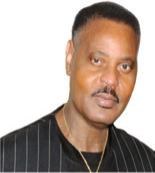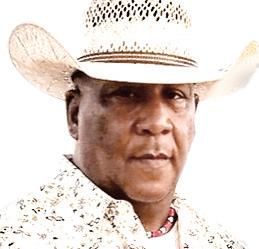AframNews.com
“Addressing Current & Historical Realities Affecting Our Community”

AI IS TAKING OVER
PASTOR JAMES NASH OBITUARY


— AND BLACK WORKERS ARE THE FIRST TO GO
By: Roy Douglas Malonson
AI is changing everything, but not everyone is bene ting. While tech companies brag about “the future,” thousands of Black workers across America are quietly losing their jobs to machines that don’t need lunch breaks, don’t take vacations, and don’t earn a paycheck. For decades, we fought to earn a place in the workforce, and now that same system is pushing us out—silently, e ciently, and without remorse. Look around and you can already see it. Selfcheckout lanes replaced cashiers. Delivery drones and driverless trucks are replacing people who’ve spent their whole lives behind the wheel. Automated customer service bots are replacing voices that once
answered phones in call centers. And most of those jobs—the ones being replaced rst—belong to us. is isn’t just about losing work. It’s about losing security, community, and identity. ose jobs built the backbone of the Black middle class. ey helped send kids to college, pay mortgages, and keep food on the table. Now, one new piece of so ware or machine can wipe out hundreds of those same positions overnight.
It’s easy to say “learn to code,” but that’s not realistic for everyone. Many of our schools don’t have access to tech programs or AI education. In some Workers on pg. 3















Today, our community grieves the loss of a truly remarkable leader, Pastor James Nash. For decades, Pastor Nash was more than just a spiritual guide — he was a cornerstone of Sunnyside’s progress and unity. His leadership extended far beyond the walls of his church, touching every corner of our neighborhood. rough his unwavering commitment to service, Pastor Nash became a beacon of hope for those seeking guidance, a voice for those who felt unheard, and a tireless champion for positive change.
A voice for justice, unity, and hope, Pastor Nash dedicated his life to creating opportunities and building bridges within our community. He worked tirelessly to improve the quality of life for residents, advocating for fair treatment, equal access, and community empowerment. rough faith, compassion, and action, he showed us that leadership is not just about words — it’s about showing up, standing up, and li ing others along the way. His ministry was rooted in love and inclusion, and his example inspired countless others to serve. Pastor Nash’s legacy will live on in the people he touched, the lives he changed, and the community he strengthened. e programs he helped create, the families he counseled, and the hope he instilled will continue to shape Sunnyside for generations to come. While his passing leaves a deep void, his spirit and vision will continue to guide us forward.
I extend my deepest condolences to his family, friends, congregation, and all who had the privilege of knowing him. May we honor Pastor Nash’s memory by continuing his mission of faith, unity, and service to one another. AA
EDITORIAL

A Revival of God Consciousness
Bobby Mills, Ph.D.




TEXAS SOUTHERN UNIVERSITY
TO aframnews1982@gmail.com 713-682-1892

BOX 41820 Houston, TX 77241



Image is very important because of America’s historic racist history. us, TSU was institutionally created out of a racist mind-set. e concept of separate, but equal was never equal. Black Texans were not permitted to attend the University of Texas. What an ungodly shame. Even though tax dollars are green, not Black or White. For example, in 1946 Herman M. Sweatt, a Black man, applied for admission to UT’s Law School, and was automatically denied admission solely based upon race. Sweatt asked the state courts to order his admission, UT attempted to provide separate but equal facilities for Black law school students. e main question is whether the UT scheme violated the Equal Protection Clause/ Rules of the 14th Amendment? anks be to God the Supreme Court unanimously issued a decision for Sweatt’s admission to the UT Law School. e Supreme Court ruled that separate but equal is, by nature, unequal. Hence, since its founding in (1927) TSU has never been equitably funded by the state of Texas! In 2025, did the state of Texas decree that Texas Southern is an academic plantation system that must have White Overseers? TSU’s Board of Regents has nine members. If the desire of the state of Texas was to place a majority
block of ve Whites on TSU’s Board of Regents creating an image of an academic plantation system, it would have been intellectually more honest to place TSU in the UT System and increase its funding appropriations. In fact, the recent appointment of a majority White Board of Regents is a blatant ungodly insult to the intellectual character and integrity of the historicity of TSU. Let it be clearly understood, I am not a racist. Nor are Black people racists. Racism requires the socio-economic ability to deny individuals access to power resources. It seems obvious that Blacks do not possess the power resources to keep Whites from doing anything socio-economically they desire to do. Moreover, racism involves possessing and using institutional power to discriminate and deny access to resources. Once again, Blacks do not possess the institutional power to discriminate against nor deny anyone anything, especially Whites! Factually, Blacks did not receive the decreed/ promised forty acres and a mule (reparations), and there is absolutely nothing that can be done about it.


We Must Understand
Roy Douglas Malonson, Publisher
THE PIPELINE IS THINNING FOR BLACK TALENT IN TECH AND BEYOND
A few years ago, every big company was bragging about diversity. DEI was the buzzword. Panels, hashtags, pledges—everyone claimed they were building space for Black talent in tech. But fast forward to today, and that same energy is gone. e diversity jobs have dried up, the promises have faded, and in their place stands a cold new trend: arti cial intelligence. What’s happening right now feels like a quiet reversal. e very people who fought to make tech more inclusive are being pushed out. Black engineers, designers, and coders—those who broke into an industry that was never built for them—are now watching the door close again. Companies are cut-
ting “diversity” budgets and replacing entire departments with AI tools that don’t care who’s missing from the room. And here’s the truth no one wants to say out loud: AI doesn’t x bias. It learns it. Every system that decides who gets hired, who gets promoted, or who gets seen is built on data shaped by decades of inequality. So when people say AI is “neutral,” they’re lying. It’s only as fair as the world that built it—and that world hasn’t been fair to us. e result? e pipeline for Black talent in tech isn’t just thinning—it’s drying up. We fought to get in, only to nd that the rules have changed again. e same people who once said, “ ere’s a pipeline problem,” are now building a future where that pipeline doesn’t exist at all. If we don’t create our own lanes, we’ll be watching the next generation of tech leaders—and not one of them will look like us. at’s the hard truth. It’s time to invest in our own training programs, support Black founders, and build tech spaces that re ect our reality. Because if we wait for the system to x itself, we’ll be le out of the future we helped imagine.


Great institutions of higher learning excel at teaching and learning: faculty and student development. e primary role of the Board of Regents is to enact/establish policies and procedures that govern the administrative processes of the teaching and learning environment. Of course, fund raising is an essential responsibility of the Board of Regents. erefore, a rstclass higher education institution is built upon moral



neighborhoods, kids are still trying to get reliable Wi-Fi, while the rest of the world is already learning to build the next generation of AI. at’s how we end up behind—again.
What’s worse, the technology itself is o en biased. AI learns from data, and that data comes from a world already lled with discrimination. at means hiring systems can favor whitesounding names, facial recognition tools can misidentify Black faces, and algorithms can decide who gets called for an interview before a human ever looks at a





resume. In other words, we’re not just being replaced—we’re being overlooked.
If we don’t get involved now, the gap will grow wider. Economists warn that automation could cost millions of Black workers their jobs in the next decade. ose losses don’t just a ect individuals—they ripple through entire communities. When paychecks disappear, churches lose members, small businesses lose customers, and families lose stability. It’s a domino e ect we’ve seen before.
But we still have power. We can ght back by learning how this technology works and
nding ways to use it instead of being used by it. Black parents can start encouraging their kids to explore tech— not just as consumers but as creators. Schools and community centers can bring in programs that teach AI and robotics early. Local leaders can push for funding that brings tech training to our neighborhoods, not just downtown boardrooms.
REMEMBERING RICHARD “DICK” CHENEY
By: Fred Smith


























We also need to hold companies accountable. If a machine can take our job, that company should be required to reinvest in training us for the next one.
Richard “Dick” Cheney, a towering and o en polarizing gure in American politics, died on November 3, 2025, at the age of 84. According to a statement from his family, the cause of death was complications of pneumonia and cardiac and vascular disease. Cheney served as the 46th Vice President of the United States under George W. Bush from 2001 to 2009, a tenure widely considered the most powerful vice presidency in history. He was a key architect
of the post-9/11 “war on terror” and the subsequent 2003 invasion of Iraq, while also previously holding positions as White House Chief of Sta , a U.S. Representative from Wyoming, and Secretary of Defense. Despite surviving ve heart attacks and a heart transplant, Cheney lived a long life, passing away at his home in Wilson, Wyoming, surrounded by his wife Lynne and their daughters, Liz and Mary. Cheney’s political career began as a congressional intern in


1969. He became White House Chief of Sta for President Gerald Ford at the age of 34. He represented Wyoming in the U.S. House for six terms, from 1979 to 1989, and was known for his conservative stance.




























































































Be the one you’re meant to be. With 200+ programs, 30+ online options, and the right support, Lone Star College helps you achieve your dreams.

















THROUGH THE LENS OF TIME: BLACK HISTORY
March 1st, 1864- Rebecca Lee Crumpler became the rst Black woman to earn a medical degree.
March 2nd, 1955Claudette Colvin, a 15-year-old Black woman was arrested for refusing to give up her seat to a white woman in Montgomery, Alabama.
March 3rd, 1991- Rodney King was severely beaten by Los Angeles police o cers.
March 4th, 1877- Garett Augustus Morgan was born on, he is best known for inventing the tra c signal and gas mask.

March 5th, 1959Twenty-One Black boys were burned to death a er being locked in a segregated and neglected Arkansas “reform” school.
March 6th, 1857- e U.S. Supreme Court declared in Dred Scott v. Sandford that: Any person descended from Africans, whether slave or free, is not a citizen of the United
March 7th, 1965- “Bloody Sunday”, Alabama state police o cers attacked unarmed civil rights marchers in Selma, Alabama.
HOUSTON
FORT WORTH



TEXAS TAKEAWAY
AUSTIN
A native of Houston is garnering attention beyond the Bayou City following the election of her husband, Zohran Mamdani, as mayor of New York City on Tuesday.
Although Senate District 9 is known as a Republican stronghold, Democrat Taylor Rehmet received the most votes in Tuesday’s special election to fill the vacant seat. The district, which has been represented by Kelly Hancock since 2013, includes northern Tarrant County, much of Fort Worth, and extends into Keller and Southlake. In the 2024 presidential election, voters in the district supported Donald Trump over former Vice President Kamala Harris, 58% to 41%. In 2022, Hancock’s Democratic challenger earned 40% of the vote in the same district.
After weeks of listening to frustrated parents, the Austin Independent School District announced Tuesday that it will postpone district-wide school boundary changes and delay a decision on the potential closure of three elementary schools for at least another year. This move represents a major setback in the district’s efforts to address its multi-million-dollar budget deficit and declining student enrollment.
SAN ANTONIO
San Antonio Mayor Gina Ortiz Jones, a prominent opponent of the $1.3 billion publicly funded arena agreement, stated that she anticipates collaborating with the NBA franchise and Managing Partner Peter J. Holt to promote equitable, accessible development and revitalization in the city’s central district.

A. Philip Randolph was a prominent labor leader and civil rights activist widely regarded as an influential strategist in the fight for racial and economic justice. He founded the Brotherhood of Sleeping Car Porters (BSCP) in 1925, which became the first successful African American labor union to be granted a charter by the American Federation of Labor (AFL).













































registered, please ensure your registration is up to date. For assistance with the on-line registration process, contact MCvendors@lonestar.edu.
























A NEW LAW IS MAKING ORGAN DONATION MORE ACCESSIBLE FOR BLACK AND BROWN COMMUNITIES POLITICAL
By: Fred Smith
Not enough is being done to make organ donation more accessible for people of color — and according to Aisha Tator, there’s still a long way to go. She describes the ongoing shortage as an *organ scarcity crisis* that has escalated into a public health emergency.
“We have over 50% of New Yorkers enrolled in the New York State Donate Life Registry,” Tator told the *AmNews*. “But we have a lot of work to do. We have 8,000 people who are depending on us to be advocates.”
Tator serves as the Executive Director of Donate Life New York State, a nonpro t dedicated to increasing organ and tissue donations. e organization emphasizes the urgent need to raise awareness about the nationwide shortage of available organs.
One of the key steps toward addressing the crisis, Tator notes, is the recently passed **HEART Act** — legislation enacted in October 2025 that repeals New York’s ban on multiple listing for organ transplants. e new law allows patients to register with several transplant centers across
the state, a change advocates believe will save lives, shorten wait times, and ease the nancial burden on low-income residents who might otherwise need to seek out-of-state registration.
“We’re very proud of one of the policy initiatives that successfully made it through this year,” Tator said, referring to the HEART Act. “ e legislation not only encourages patients to register with more than one transplant center, but it also requires transplant centers— under federal policy—to inform patients, both verbally and in writing, of their right to do so. is strengthens equity and fairness within the system,” she added, “and it also brings New York in line with national standards and practices.” ere have also been notable victories in the e ort to increase organ donor registrations. In a 2024 press release, Governor Kathy Hochul announced that, for the rst time, more than half of eligible New Yorkers had signed up to become organ and tissue donors through the state’s Organ Donor Registry. ese reforms
are especially relevant for minority populations because racial and ethnic disparities in organ donation and transplantation have been well documented. Black and Hispanic Americans, for example, experience higher rates of conditions such as kidney failure but tend to wait signi cantly longer—o en 18 to 24 months longer—than White patients for a transplant. Additionally, these communities have lower rates of donor registration, o en due to historical mistrust of the medical system and lack of culturally sensitive outreach.
By improving system transparency, simplifying registration, and reducing economic barriers for living donors, these laws directly target factors that have contributed to inequitable outcomes. Furthermore, expanding donor participation within diverse communities increases the genetic diversity of available organs, which can improve matching and transplant success rates for minority patients.













LEGAL












































































